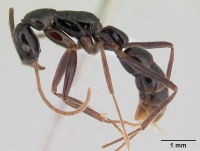Leptogenys pucuna
| Leptogenys pucuna | |
|---|---|

| |
| Scientific classification | |
| Kingdom: | Animalia |
| Phylum: | Arthropoda |
| Class: | Insecta |
| Order: | Hymenoptera |
| Family: | Formicidae |
| Subfamily: | Ponerinae |
| Tribe: | Ponerini |
| Genus: | Leptogenys |
| Species group: | luederwaldti |
| Species: | L. pucuna |
| Binomial name | |
| Leptogenys pucuna Lattke, 2011 | |
The locality is described as a ridge top montane forest and the specimen was taken from a leaf litter sample.
Identification
A member of the luederwaldti species group. Body mostly black, head with blue iridescence; eyes close to lateral cephalic mid distance with a diameter close to one-fourth the length of the lateral cephalic margin; petiolar node semi-triangular, elongate and low in height; mesonotum wider than long; postpetiolar constriction well marked. (Lattke 2011)
Keys including this Species
Distribution
Latitudinal Distribution Pattern
Latitudinal Range: 0.1168° to 0.092777778°.
| North Temperate |
North Subtropical |
Tropical | South Subtropical |
South Temperate |
- Source: AntMaps
Distribution based on Regional Taxon Lists
Neotropical Region: Ecuador (type locality).
Distribution based on AntMaps
Distribution based on AntWeb specimens
Check data from AntWeb
Countries Occupied
| Number of countries occupied by this species based on AntWiki Regional Taxon Lists. In general, fewer countries occupied indicates a narrower range, while more countries indicates a more widespread species. |

|
Estimated Abundance
| Relative abundance based on number of AntMaps records per species (this species within the purple bar). Fewer records (to the left) indicates a less abundant/encountered species while more records (to the right) indicates more abundant/encountered species. |

|
Biology
|
Castes
Queens and males are unknown.
Nomenclature
The following information is derived from Barry Bolton's Online Catalogue of the Ants of the World.
- pucuna. Leptogenys pucuna Lattke, 2011: 187, fig. 41 (w.) ECUADOR.
Unless otherwise noted the text for the remainder of this section is reported from the publication that includes the original description.
The eyes in L. pucuna are not as displaced dorsad on the head as in other species of the luederwaldti group, and it is also different in the present of an internal seta in the interior apex of the meso and well as metatibia, though more specimens are needed to establish the constancy of these characters. In the individual studied the iridescence is only present on the head. The relatively large basal mandibular sulcus creates a notch on the mandibular external margin.
Description
Worker
Metrics, holotype: HL 1.37; HW 0.83; ML 0.61; EL 0.23; SL 1.59; PW 0.76; WL 2.23; PH 0.48; PL 0.86; DPW 0.46 mm. CI 0.61; MI 0.73; OI 0.27; SI 1.91; LPI 0.56; DPI 0.53.
Head elongate in full-face view, wider anterad than posterad, posterior margin straight, lateral margin broadly convex, anterior clypeal margin tapers to a pointed triangular median lobe, lateral lobes inconspicuous. Cephalic dorsum mostly smooth and shining with scattered piligerous punctulae, clypeus with longitudinal striae; compound eye convex, situated slightly anterad of lateral cephalic mid-length, its diameter about one-fourth length of lateral cephalic margin. Scape surpasses posterior cephalic border by slightly more than one-third its length, thickest close to mid-length in cephalic full-face view; third antennal segment more than 3 × longer than width, second and fourth antennal segments each respectively over two-thirds length of segment III. Mandible with semi-parallel external and basal margins in cephalic full-face view; basal margin mostly convex, slightly concave close to basal angle; external margin with discrete but well-defined angle close to the mandibular base originating from the basal sulcus that divides the external margin into short posterior basal margin and much longer anterior margin.
Mesosoma with well-defined but shallow metanotal groove in lateral view that divides promesonotal convexity from lower, mostly straight propodeal dorsal margin; declivitous margin weakly convex with small triangular lobe posterad of spiracle; spiracle broadly oval, not significantly elevated over surrounding cuticle. Mesopleuron with anteroventral carina that widens anterad into brief triangular lobe; mesometapleural suture scrobiculate. Mesosoma mostly smooth and shining except for some striae along posteroventral mesopleuron, metapleuron close to bulla, and propodeal declivity anterad of lateral lobes; declivity with broad sulcus between lobes and petiolar insertion. Width of mesonotum in dorsal view more than twice its length.
Petiole semi-triangular in lateral view, relatively low with brief vertical anterior margin followed by long, straight sloping anterodorsal margin, apex rounded, posterior margin weakly convex. Node elongate in dorsal view, anterior margin half width of posterior margin, lateral margin broadly concave; anterior margin of postpetiole convex in lateral view; constriction between abdominal segments III and IV well marked; hypopygidium without median carina. Gaster mostly smooth and shining with scattered piligerous punctae. Mandible, legs, and gastral apex brown; clypeus, scape dark brown; funiculus light brown; most of head, mesosoma, petiole and gaster back; head with blue iridescence. Body without pubescence, with sparse subdecumbent to suberect fine hairs; scape with subdecumbent hairs mostly of same length but with several of varying lengths.
Type Material
Holotype worker. Ecuador, Pichincha, R.B. Maquipucuna, 1620 m, 00°05′34′′N 78°37′37′′W, 29.x.1999-213, R. Anderson. One worker deposited in California Academy of Sciences.
Etymology
The species name is derived from that of the type locality Maquipucuna.
References
- Esteves, F.A., Fisher, B.L. 2021. Corrieopone nouragues gen. nov., sp. nov., a new Ponerinae from French Guiana (Hymenoptera, Formicidae). ZooKeys 1074, 83–173 (doi:10.3897/zookeys.1074.75551).
- Lattke, J.E. 2011. Revision of the New World species of the genus Leptogenys Roger (Insecta: Hymenoptera: Formicidae: Ponerinae). Arthropod Systematics & Phylogeny. 69:127-264.
References based on Global Ant Biodiversity Informatics
- Lattke J. E. 2011. Revision of the New World species of the genus Leptogenys Roger (Insecta: Hymenoptera: Formicidae: Ponerinae). Arthropod Systematics and Phylogeny 69: 127-264

